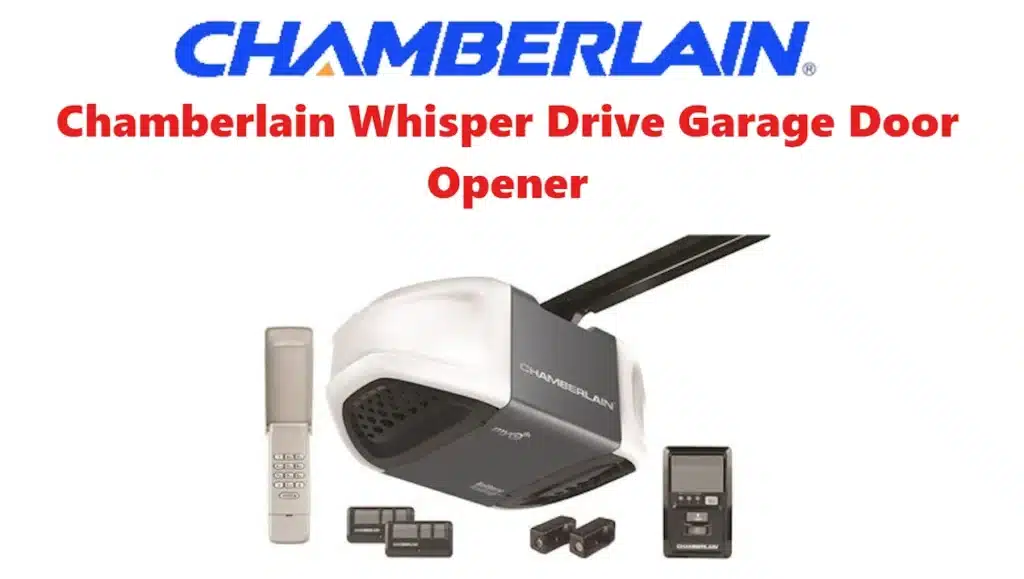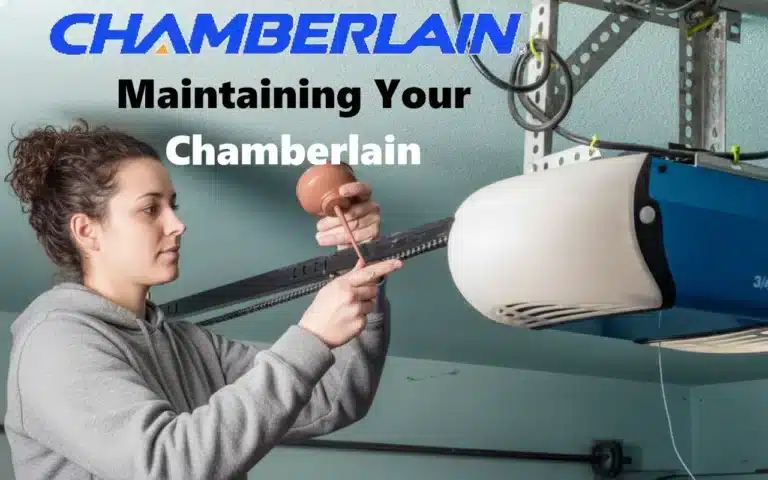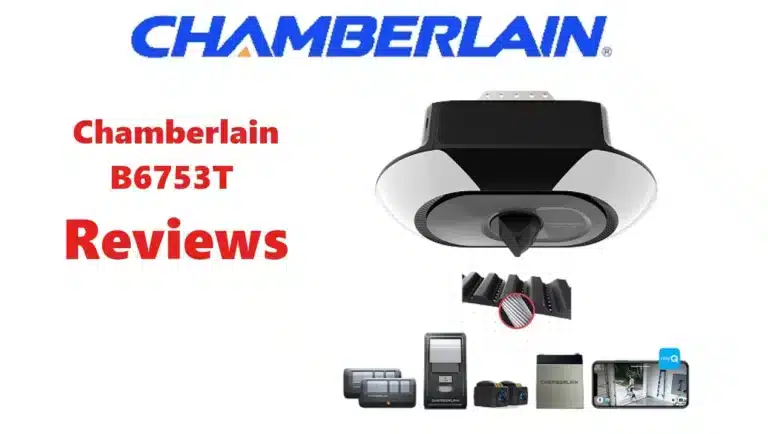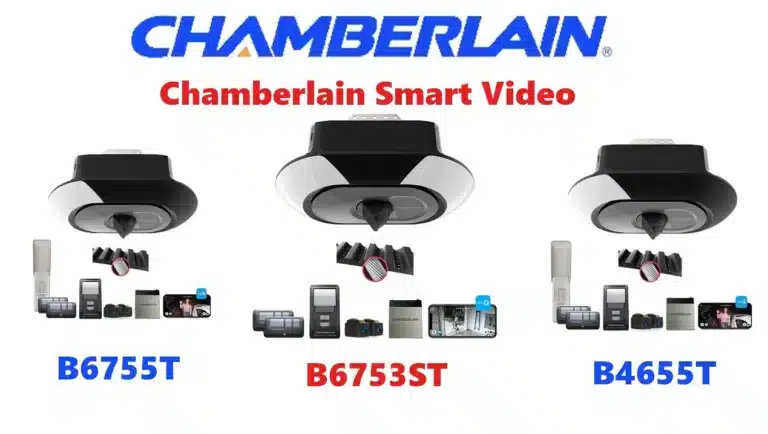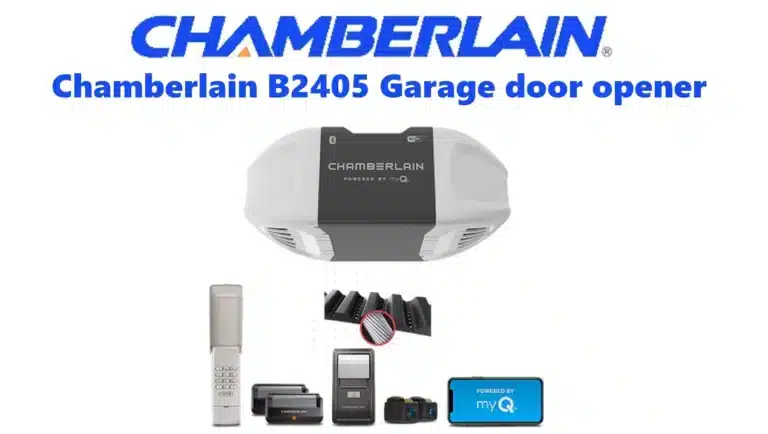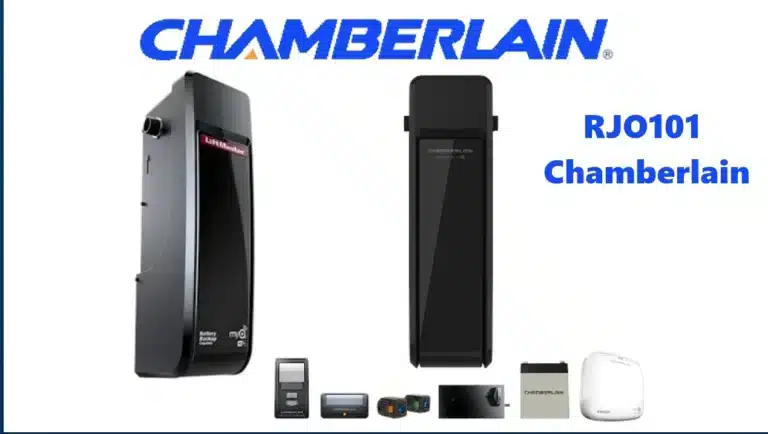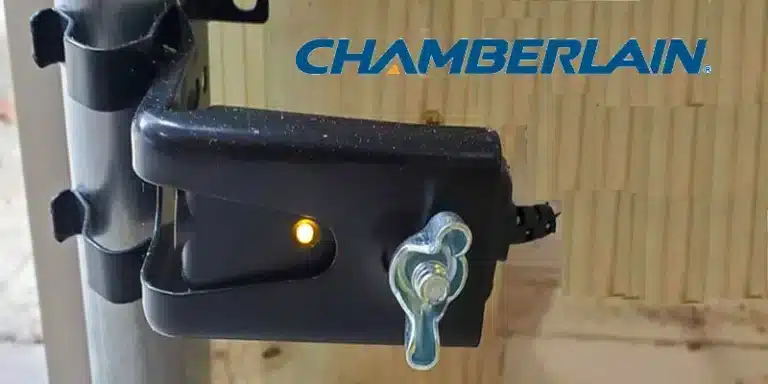The Chamberlain Whisper Drive is a line of belt-drive garage door openers known for extremely quiet operation and dependable performance. It became one of Chamberlain’s most popular opener series, emerging during a time when homeowners were seeking quieter alternatives to noisy chain drives. “Whisper Drive” models achieve their silence by using a steel-reinforced belt and a smooth DC motor, greatly reducing vibration and noise compared to older openers.
These openers were offered in different configurations over the years – from 1/2 horsepower units (often with AC motors on early models) to 3/4 horsepower units with DC motors and battery backups on later models. In short, a Chamberlain Whisper Drive opener is designed to quietly and reliably lift your garage door, packed with user-friendly features that made it a top choice for attached garages and noise-sensitive installations.
Chamberlain Whisper Drive garage door opener (model WD962KEV) with its belt-drive rail and included accessories. This 3/4 HP Whisper Drive model features a battery backup system and is known for its ultra-quiet operationl.
Best Chamberlain Whisper Drive Models and Features
Chamberlain Whisper Drive openers came in several models over the years. Here we highlight two of the best-known Whisper Drive models and their key features. Each model in the Whisper Drive series shares the core benefits of quiet belt-drive performance, but they differ in horsepower and extras like connectivity and backup power.
Chamberlain Whisper Drive WD832KEV (1/2 HP Belt Drive)
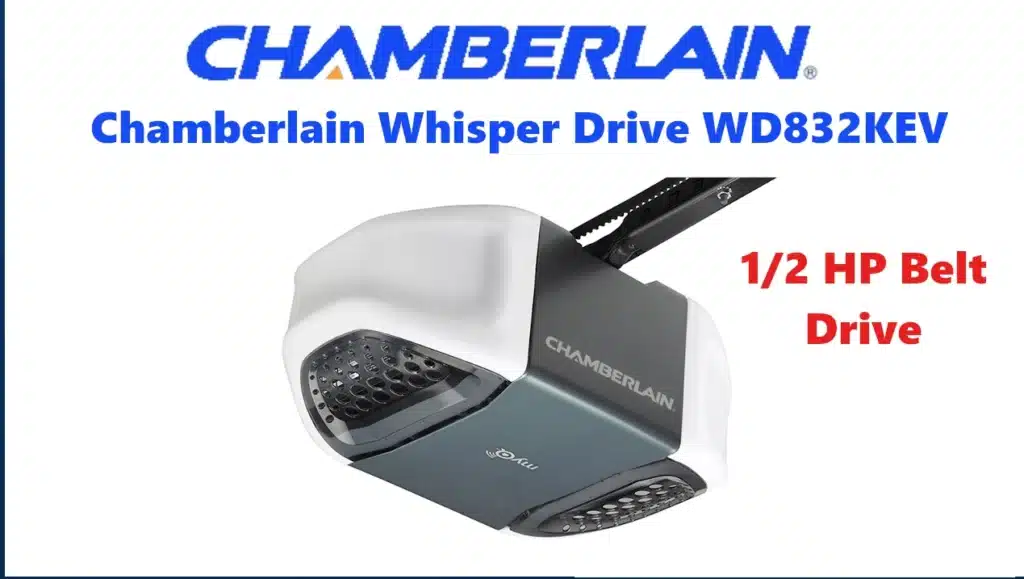
The Chamberlain WD832KEV is a popular 1/2 HP Whisper Drive opener ideal for standard garage doors. This model uses a 1/2 horsepower DC motor with a steel-reinforced belt, delivering ultra-quiet operation that’s perfect for garages adjacent to living spaces. Despite its smaller motor, it’s powerful enough to handle a typical 7-foot tall residential garage door (extension kits are available for 8-10 ft doors).
Key features of the WD832KEV include a lifetime warranty on the motor and belt, reflecting its durable build. It comes with two 3-button remote controls, a wireless exterior keypad, and a multi-function wall control panel, giving you multiple convenient ways to operate your door. The unit is MyQ® compatible, meaning you can upgrade it for smart-phone control – with the addition of Chamberlain’s Internet Gateway, you can monitor and control your garage door from anywhere via the MyQ app. HomeLink® buttons in many cars will also work with this opener for in-vehicle control. For safety and convenience, the WD832KEV includes motion-sensing lights and a Timer-to-Close function that can automatically close the door after 1, 5, or 10 minutes if you forget. Overall, the WD832KEV offers a blend of quiet performance and modern features, making it a solid choice for most homes.
Chamberlain Whisper Drive WD962KEV (3/4 HP Belt Drive with Battery Backup)
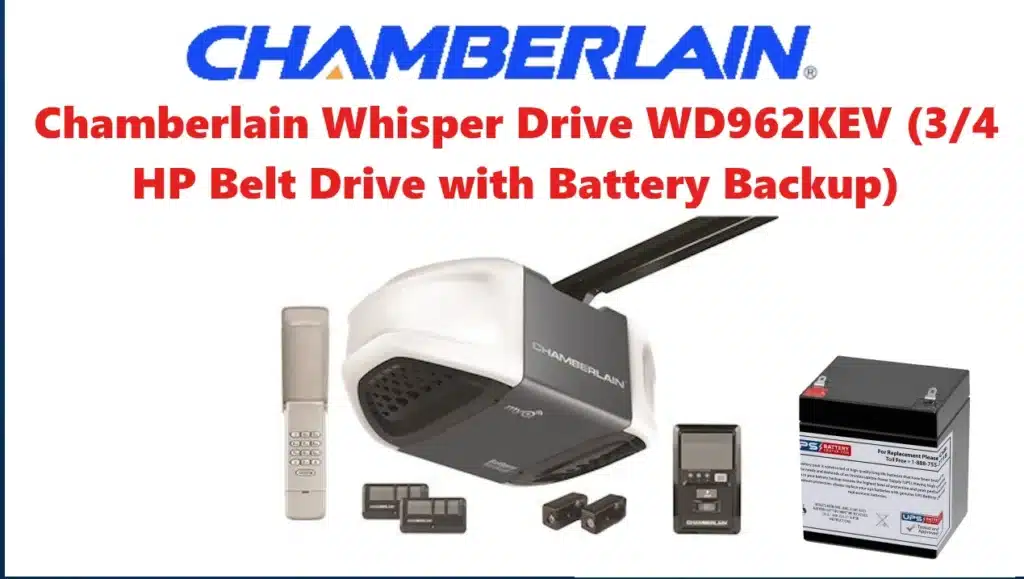
For those needing a bit more power and backup capabilities, the Chamberlain WD962KEV Whisper Drive was the top-tier model. It boasts a 3/4 HP (equivalent) DC motor that delivers the “ultimate in quiet performance” for even heavier or large two-car garage doors. What sets the WD962KEV apart is its integrated EverCharge® Battery Backup system: if your house power goes out, the opener can still operate up to 20 open/close cycles in the first 24 hours of an outage on the battery supply. This gives peace of mind that you won’t be locked out during storms or power failures.
The WD962KEV shares many features with the 1/2 HP model, plus some premium upgrades. It comes with two 3-button remotes, a wireless keyless entry pad, and an upgraded control panel. The motion-detecting control panel not only turns on the lights when it senses movement in the garage, but also makes it easy to program remote controls and keypads right from the wall console. Like its smaller sibling, this model is MyQ-enabled (it can be connected to your home network for smartphone control with the add-on Internet Gateway).
It also retains conveniences like the Timer-to-Close feature and automatic force-sensing technology, which adjusts the opener’s force based on temperature and door conditions. The WD962KEV includes a lifetime warranty on the motor and belt, underscoring its high build quality. Overall, the 3/4 HP Whisper Drive offers maximum quiet power and backup reliability – an excellent choice for larger doors or anyone who values never being stuck if the power goes out.
How to Program the Chamberlain Whisper Drive
Programming a Chamberlain Whisper Drive garage door opener – whether adding a new remote control or setting up the wireless keypad – is a straightforward DIY process. These openers use rolling code technology and a “Learn” button on the motor unit for easy syncing of accessories. Here’s a quick guide to programming your Whisper Drive opener:
1. Locate the Learn button: On your Chamberlain Whisper Drive opener, find the Learn (or “Learn Code”) button on the unit. Depending on the model, it may be on the back or side of the motor head (often near the antenna wire). The button could be purple, yellow, or another color – Whisper Drive units commonly have a purple Learn button on the circuit board for older models, or yellow on the last models produced.
2. Enter learning mode: Press and release the Learn button. The opener’s indicator LED will light up (or sometimes blink) to signal that the unit is in programming mode. You now have 30 seconds to complete the next step.
3. Program the remote or keypad: Within 30 seconds of pressing Learn, do one of the following:
- For a remote control – Press and release the button on the remote that you want to program to the opener. You should see the opener’s light blink or hear a click, confirming the remote was learned successfully. Repeat for any additional remotes, pressing the Learn button for each one.
- For the wireless keypad – At the keypad, enter your chosen 4-digit PIN, then press the “Enter” key. Do this within 30 seconds of hitting the opener’s Learn button. The opener light will flash to confirm the keypad code has been accepted. Now you can use that PIN to open/close the door from outside.
That’s it! After these steps, your new remote should activate the door, or your outside keypad should be able to open the garage using the PIN you set. If programming multiple remotes or keypads, remember to press the Learn button each time and then the respective remote button or keypad code within 30 seconds.
Chamberlain Whisper Drive Programming Tips
Even though programming is simple, here are a couple of handy tips for managing your Whisper Drive opener’s settings:
- Erasing old codes: If you move into a home with an existing Chamberlain Whisper Drive or ever lose a remote, it’s wise to clear the opener’s memory for security. To do this, press and hold the Learn button for about 6–10 seconds until the LED turns off. This will erase all remote controls and keypads from the opener’s memory. You can then reprogram your own remotes/PINs from scratch, ensuring any lost or previously paired devices won’t work anymore.
- Programming HomeLink in your vehicle: Many cars have built-in HomeLink buttons that can be programmed to your garage opener. The Whisper Drive is HomeLink-compatible. Generally, you’ll press the Learn button on the opener, then within 30 seconds press and hold the desired HomeLink button in your car until the garage door opener light flashes. (Some newer vehicles may require a compatibility bridge if they use newer Security+ 2.0 rolling codes.) Always consult your car’s manual for specific HomeLink programming instructions.
By following these programming steps and tips, you can easily sync new remotes or set up keyless entry for your Chamberlain Whisper Drive, adding convenience and maintaining security for your garage.
Common Chamberlain Whisper Drive Problems and Troubleshooting
Like any garage door opener, the Chamberlain Whisper Drive can encounter issues over time. Below are some common problems owners might face with Whisper Drive openers, along with troubleshooting tips to resolve them:
Door won’t close or reverses immediately:
If your garage door starts to close then reverses (often accompanied by the opener lights flashing 5 times), the likely culprit is the safety sensors. Chamberlain Whisper Drive openers have infrared safety sensor eyes at the base of the door tracks. Check that these sensors are aligned (the indicator LEDs on both sensors should be lit steady) and that nothing is blocking the beam. Even if they look aligned, it helps to clean the sensor lenses of any dust or cobwebs, as grime can weaken the beam. Also ensure direct sunlight isn’t interfering.
If the sensors are fine, the issue could be the down force setting – if the close-force is set too low, the opener may interpret normal resistance as an obstruction and reverse the door. Try gradually increasing the down force slightly and test the door again. Always only increase force to the minimum level necessary for safety. (If you’re comfortable, Chamberlain manuals detail how to adjust the force via a dial on the unit.) These steps fix the vast majority of closing issues since sensors and force limits are a common cause.
Opener is beeping every 30 seconds:
A periodic beep (usually accompanied by a flashing LED on the unit) is a specific alert for Whisper Drive models equipped with a battery backup. It means the backup battery needs replacement. The battery is typically a 12V rechargeable unit located in the opener housing. To fix this, open the battery compartment (usually behind a small panel on the motor unit), and swap the old battery for a new one – a process involving just disconnecting a red and black wire and removing the battery. After installing a fresh battery, the beeping will stop. Chamberlain recommends replacing the battery roughly every 3–5 years. Always dispose of the old battery properly.
Travel limits or trolley issues:
If your door overshoots and hits the floor hard when closing, or stops short of fully opening, the travel limits may be misadjusted. With Whisper Drive openers, you set the up/down travel electronically (via the adjustment buttons on the unit). Refer to your manual’s instructions to reprogram the travel limits so the door stops in the correct positions. In some cases, if the opener’s limits refuse to program correctly or don’t hold the setting, it could indicate a circuit board issue. Some Whisper Drive units (especially later DC motor models with electronic limits) were known to have occasional logic board glitches that prevent the travel from calibrating.
If you’ve attempted to reset the limits and the opener still drives the door too far (often causing the trolley to jam against the stop bolt), you might need to reset the opener by unplugging it for a minute, or ultimately replace the control board. Persistent limit-setting problems that can’t be resolved may require contacting a professional or considering a new opener, as a faulty board can be costly to fix.
Belt wear and maintenance:
One advantage of belt drive openers is low maintenance, but the belt will wear out after years of use. Around the 8-10 year mark, you might notice the belt starting to fray or lose teeth (the rubber cogs that grip the motor sprocket). A worn belt can cause slippage, noise, or difficulty opening the door. Inspect the belt – if you see steel strands showing or missing ridges, it’s time to replace it. Chamberlain Whisper Drive models typically use the 41A5250 belt assembly, a common replacement part.
Replacing the belt is a moderate DIY task (you’ll need to release tension and feed the new belt in); otherwise, hire a garage door technician. Regularly check belt tension and tighten it if it becomes too slack over time (your manual will have the procedure). Keeping the door hardware well-lubricated (springs, hinges, rollers) can also reduce strain on the opener, helping the belt last longer.
Remote or keypad not working:
If your remote control stops opening the door, first check the battery in the remote – a simple coin-cell battery change often solves intermittent range or response issues. If the remote’s battery is fresh but it still won’t work, try reprogramming the remote using the Learn button steps above. Sometimes remotes can lose their coding after a power surge or if the opener’s memory was cleared. Similarly, for a wireless keypad that isn’t responding, reprogram the PIN using the Learn button and ensure the keypad’s 9V battery (if external) is good. Also, verify that the lock feature on your wall control isn’t accidentally activated – many Chamberlain wall panels have a “Lock” or “Vacation” switch that, when on, disables all remote signals (the door will only open from the wall button until unlocked). Unlocking that will restore remote functionality.
By troubleshooting these common issues, you can often get your Chamberlain Whisper Drive opener running smoothly again without a service call. Always remember to exercise caution when working on an opener: if a problem persists or seems complex (e.g. springs or serious electrical issues), consider contacting a professional garage door technician for safety.
The Chamberlain Whisper Drive series offers an excellent blend of quiet operation and user-friendly features, making it a favorite for many homeowners. While the Whisper Drive line has been discontinued in favor of Chamberlain’s newer smart openers with built-in Wi-Fi, cameras, and LED lighting, many units are still in service and performing well. If you have a Whisper Drive, you own a reliable, proven garage door opener that, with a little care and maintenance, will continue to quietly do its job for years. And when it eventually comes time to upgrade, you’ll find that Chamberlain’s latest models carry on the Whisper Drive’s legacy of innovation and convenience – now with even more high-tech bells and whistles. For now, enjoy the peace and quiet every time you open your garage with a Chamberlain Whisper Drive!




